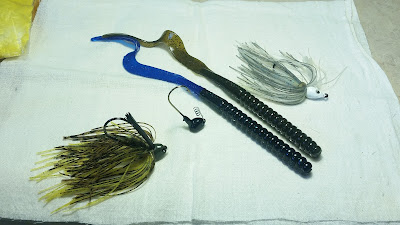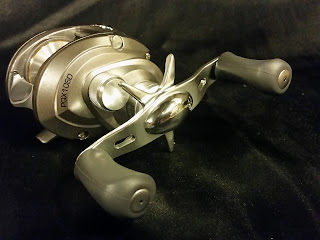 |
| Summer SML pig |
Smith Mountain is my home water and like any major reservoir it has its seasonal patterns, and it has spots that are more productive than others given the prevailing weather. A trap that I fell into early on in the month was assuming that my previous knowledge and experiences would hold true without taking into account some of the anomalous weather conditions this year leading into August. It took me a lot of trial and error to realize that the abnormally wet weather coupled with moderately high temperatures of the previous months had thrown the bass, well more the bass angler, a curve ball but once I threw out what I thought I "knew" and fished the actual conditions a solid pattern emerged that I think just about anyone could replicate out there in the future.
As I stated above, we have had a pretty wet year up to this point. In dry years past conventional wisdom said that during the heat of summer you should fish deep brush piles submerged in up to 30ft of water. While I did catch some fish like this early on in the month, heaving a big worm and dragging it slowly, the fish I caught were no where near the size I had hoped. Except for a couple fish in the 2-3lb range most everything down that deep were babies, and I will go into why I think this was the case a little later on. With the limited success going by conventional wisdom I had to start hunting down the big girls with an open mind and clean slate.
Hunting bass is exactly what I started to do by the 2nd week of August. As I paddled around the various areas of the lake and by the innumerable boat docks that studded the shore I started to notice that my sonar was returning what looked to be a lot of fish suspended off the ends of all those party platforms. Me, being an optimist, started trying to target these fish that were just hanging out, but that effort turned to frustration exceedingly quick. Every time I would see fish on the screen I would cast, drag, shake, twitch, burn, etc etc whatever I could trying to entice just one of them to eat but nada. One thing I can say about having a fish finder is that it can and will make you want rip it off your kayak and watch it sink to the inky abyss in short order.
After a few outings I lucked into a few fish but never found any solid pattern. The pressure of a month long online tournament was getting to me as the leaders were pulling hard and fast away from my meager bag for the month. Not one to be discouraged (or maybe too dumb to know I'm beat) I kept trudging along. One afternoon I came across another boat slip and my HumminBird Helix screen was lit up yet again. This time however I noticed something just a little different, with the returns of what looked like bait there were also sharp straight returns going up and down at an angle. On a whim I threw out my Meador Custom Jigs shakeyhead parallel to the front of that dock, gave it a few quick twitches and BOOM! After hauling in a fat 3lb bass I figured why not give it another cast, and again in short order I had a second fat fish in the boat. I repeated the process 3 more times pulling 3 more cookie cutter fish off of the same spot, and thats when the little 10 watt lightbulb went on in my noggin. Those fish were actively feeding and that is what I was seeing on my sonar. I made some mental notes of depth, retrieve, and bottom composition/bottom cover then headed looking for more of the same. It didn't take me long to come across a similar situation a little ways around the bend and with fingers crossed I chucked my shakeyhead out. This time I got hit like a freight train and after a long and harrowing fight on a wet noodle spinning rod I hauled out a 21" 6lb+ pig. It was game on cuz daddy figured out the pattern.
Over the following weeks I spent more time and energy paddling around the lake looking for the right set of conditions and active fish than I did with a line in the water. All the effort it took was well worth it as I was rewarded with a monthly total of over 100" in the dead of summer and tourist season on the busiest lake in Virginia. Not only did I find big fish but the pattern I found produced quantity on almost every trip with even the smaller fish being in the 2-4lb range.
Now that you have suffered through my incessant ramblings here are the juicy details that I hope can put you guys on some fish out there as well.
1) Not all docks are created equal: I found out quickly that docks with little to no structure on the bottom rarely held fish, or the fish that I would mark would be suspended and I couldn't get them to eat. If you find a dock that has some brush or rock off the front it will be worth a look. If you don't mark fish on a dock like that today, remember it and check it out periodically because at some point there will be catchable bass there. I made loops in some areas going from one dock I knew had structure to the next until I hit them all and started over again. On more than one occasion I came back to a likely looking spot later on to find fish on it.
2) Depth is relative: Being summer I always think deep is 20 feet or more and that is where the fish will hold due to the heat. Well most if not all the fish on this pattern were caught anywhere from 10-15ft with deeper water adjacent.
3) Keep your bait in the fishes face: I made it my number 1 priority to keep my bait on the same level as the fish. In general I cast parallel to depth changes, if you mark the fish at 15ft then cast to where its 15ft deep and retrieve it along that 15ft line. I didn't want my bait coming up or down a slope on a drop off
4) Slow is your friend: I know that there are a million ways to catch fish and some folks love to power fish. I (as Danny will tell you) am the slowest fisherman on earth. I have no problem fishing a single deadfall for an hour. I'm not going to say that anyone else should do the same but in this instance going slow produced time and again over a speedy approach. I think in the heat some of these big fish get a little lethargic and aren't willing to chase down a meal. Make multiple casts because it may be the difference in a few inches or a foot that triggers big mama to eat.
5) Trust your electronics: If you have a depth finder on you kayak then learn to use it. Play with the settings to optimize your readout. Above all learn what it is that the screen is telling you. A huge advantage this month was picking out actively feeding fish versus ones that were just milling around. While I might get lucky and tempt a neutral fish into eating, I could almost always get one or more active fish to chew.
6) Finesse isn't just for numbers: I know that some folks will say that finesse fishing isn't for catching big bass. Well Smith Mountain lake isn't a typical reservoir when it comes to tactics. While crank baits, spinnerbaits and the like have their time and place on the lake I would say that most of the year the angler willing to slow down and do some finesse fishing will be rewarded more often than not. I did the majority of my work with a shakeyhead with a smattering of Texas rigged worms and various jigs thrown in. Big fish WILL eat a small bait.
 |
| The Meador Custom Jigs Shakeyhead did most of the work but the Swim Jig and Brush Jig got in on the action too as well as some 10" Berkley Power Worms |
Finally, why were the fish not where they were "supposed" to be this time of year. I think that the high frequency of rain we have had this year has kept the water cooler and more oxygenated in the 10-20ft range than in years past. Couple that with the higher than average temperatures earlier in the year and the deep water has lost a large part of its dissolved oxygen content pushing bass up in the water column. These are just a few things to keep in mind for future fishing trips during the Dog Days of Summer.
Tight lines,
Damian
















